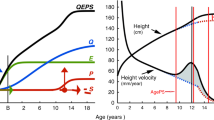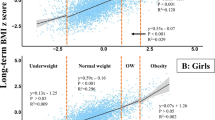Abstract
Objective: To investigate the prevalence of low body weight in Beijing pubertal girls and to establish the cut-off for body mass index (BMI) for underweight for Chinese pubertal girls.
Design: Cross-sectional study.
Setting: Three socioeconomic areas (rural, suburban and urban) in Beijing, China.
Subjects: Random sample of 1214 adolescent girls aged 12–14 y from 13 middle schools.
Results: Using a modified Chinese reference, the rate of low body weight (BMI<18) was 32.2% (95% CI 29.6–34.8%). Compared with desirable weight girls (BMI=18–21), girls with low body weight had a lower bone age, delayed breast and pubic hair development, a lower rate of menarche, lower distal one-third radius and ulna bone mineral content (BMC), bone mineral density and bone width. Logistic regression showed that BMI was one of the predictors of one-third ulna BMC after adjustment for confounding variables. When comparing BMI<18 vs BMI=18–21, the risk of BMC being less than the median increased by 82% (odds ratio 1.82, 95% CI 1.06–3.13). Thinness and stunting rates assessed by WHO recommended cut-offs are also reported.
Conclusions: High prevalence of low body weight (BMI<18) was found to be a major health problem among Beijing pubertal girls. BMI<18 is confirmed as the cut-off for delayed general growth and development for Chinese girls and for screening girls at risk of lower bone mineral status.
Sponsorship: The research was supported in part by the Dairy Research and Development Corporation, Australia.
This is a preview of subscription content, access via your institution
Access options
Subscribe to this journal
Receive 12 print issues and online access
$259.00 per year
only $21.58 per issue
Buy this article
- Purchase on Springer Link
- Instant access to full article PDF
Prices may be subject to local taxes which are calculated during checkout

Similar content being viewed by others
References
Adelaide Children's Hospital (1989). Stages of Puberty, Sydney: Pharmacia & Upjohn
Block, G, Hartman, AM, Dresser, CM, Carroll, JG & Gardner, L (1986). A data-based approach to diet questionnaire design and testing. Am. J. Epidemiol., 124, 453–469.
Chang, Y, Zhai, F, Li, W, Ge, K, Jin, D & de Onis, M (1994). Nutritional status of preschool children in poor rural areas of China. Bull. WHO., 72, 105–112.
Cole, TJ, Bellizzi, MC, Flegal, KM & Dietz, WH (2000). Establishing a standard definition for child overweight and obesity worldwide: international survey. Br. Med. J., 320, 1240
Daniels, SR, Khoury, PR & Morrison, JA (1997). The utility of body mass index as a measure of body fatness in children and adolescents: differences by race and gender. Pediatrics, 99, 804–807.
De Onis, M, Dasgupta, P, Saha, S, Sengupta, D & Blössner, M (2001). The National Center for Health Statistics reference and the growth of Indian adolescent boys. Am. J. Clin. Nutr., 74, 248–253.
Du, X, Greenfield, H, Fraser, DR, Ge, K, Trube, A & Wang, Y (2001). Vitamin D deficiency and associated factors in adolescent girls in Beijing. Am. J. Clin. Nutr., 74, 494–500.
Greulich, WW & Pyle, SI (1959). Radiographic Atlas of the Skeletal Development of the Hand and Wrist, 2nd edn California: Stanford University Press
He, W, Du, X & Greenfield, H (1997). CAVD, a Survey System Using Epi Info, Beijing: Chinese Academy of Preventive Medicine (Diskette)
Hediger, ML & Stine, RA (1987). Age at menarche based on recall information. Ann. Hum. Biol., 14, 133–142.
Hui, SL, Slemenda, CW & Johnston, CC (1989). Baseline measurement of bone mass predicts fracture in white women. Ann. Intern. Med., 111, 355–361.
Institute of Nutrition and Food Hygiene (1991). Food Composition Tables, Beijing: People's Health Publishing House
Ito, M, Yamada, M, Hayashi, K, Ohki, M, Uetani, M & Nakamura, T (1995). Relation of early menarche to high bone mineral density. Calcif. Tissue Int., 57, 11–14.
Lin, WS, Chen, CN, Su, JZX, Zhu, FC, Xing, WH, Li, JY & Te, GS (1992). The menarcheal age of Chinese girls. Ann. Hum. Biol., 19, 503–512.
Luciano, A, Bressan, F & Zoppi, G (1997). Body mass index reference curves for children aged 3–19 years from Verona, Italy. Eur. J. Clin. Nutr., 51, 6–10.
Matkovic, V, Fontana, D, Tominac, C, Goel, P & Chesnut, CH III (1990). Factors that influence peak bone mass formation: a study of calcium balance and the inheritance of bone mass in adolescent females. Am. J. Clin. Nutr., 52, 878–888.
Ministry of Health and National Education Committee (1993). Chinese Reference Standards for Anthropometry Assessment of School Children, Beijing: MH & NEC
Pietilainen, KH, Kaprio, J, Rissanen, A, Winter, T, Rimpela, A, Viken, RJ & Rose, RJ (1999). Distribution and heritability of BMI in Finnish adolescents aged 16y and 17y: a study of 4884 twins and 2509 singletons. Int. J. Obes. Relat. Metab. Disord., 23, 107–115.
Prentice, A, Parsons, TJ & Cole, TJ (1994). Uncritical use of bone mineral density in absorptiometry may lead to size-related artifacts in the identification of bone mineral determinants. Am. J. Clin. Nutr., 60, 837–842.
Rosen, CJ (1996). Osteoporosis: Diagnostic and Therapeutic Principles, Totowa, NJ: Humana Press
Schaefer, F, Georgi, M, Wuhl, E & Scharer, K (1998). Body mass index and percentage fat mass in healthy German schoolchildren and adolescents. Int. J. Obes. Relat. Metab. Disord., 22, 461–469.
Tanner, JM (1962). Growth at Adolescence, pp30–36, Oxford: Blackwell Scientific Publications
Wang, Y, Popkin, B & Zhai, F (1998). The nutritional status and dietary pattern of Chinese adolescents, 1991 and 1993. Eur. J. Clin. Nutr., 52, 908–916.
Wang, Y, Ge, K & Popkin, BM (2000). Tracking of body mass index from childhood to adolescence: a 6-y follow-up study in China. Am. J. Clin. Nutr., 72, 1018–1024.
Wasnich, RD, Ross, PD, Davis, JW & Vogel, JM (1989). A comparison of single and multi-site BMC measurements for assessment of spine fracture probability. J. Nucl. Med., 30, 1166–1171.
WHO (1983). Measuring Change in Nutritional Status, Geneva: WHO
WHO Expert Committee (1995). Physical Status, the Use and Interpretation of Anthropometry, WHO Technical Report Series no. 854 Geneva: WHO
Ye, GS, Lin, ZZ, Lin, WS, Li, BW, Tang, XW & Bian, GN (1981). A study of Beijing student adolescence. Chin. Med. J., 94, 101–108, (in Chinese)
Acknowledgements
The authors are indebted to Professor GS Ma, Mr XW Li, Ms GS Liu, Mr XX Li, Miss JJ Tan, Mr JM Zhu and his staff, Professor W He, Mr BM Guo, Ms JX Gao, Miss H Wang, Professor A Baumann, Dr D Mackerras, Ms E Emmerson for their help and technical assistance in the project. The authors are grateful to all principals, staff and health workers involved for their effort and contribution to the fieldwork and all subjects and their parents for their cooperation.
Author information
Authors and Affiliations
Contributions
Guarantors: X Du, H Greenfield and DR Fraser.
Contributors: The study was designed by XD, HG and DRF; data collection was carried out by XD, WZ, LH and ZL. The study was supervised by HG, DRF and KG. XD did data analysis and prepared versions of the paper. HG and DRF finalized the paper. All authors read and commented on the paper.
Corresponding author
Rights and permissions
About this article
Cite this article
Du, X., Greenfield, H., Fraser, D. et al. Low body weight and its association with bone health and pubertal maturation in Chinese girls. Eur J Clin Nutr 57, 693–700 (2003). https://doi.org/10.1038/sj.ejcn.1601599
Accepted:
Published:
Issue Date:
DOI: https://doi.org/10.1038/sj.ejcn.1601599
Keywords
This article is cited by
-
Bone status measured by quantitative ultrasound: a comparison with DXA in Thai children
European Journal of Clinical Nutrition (2016)
-
Body mass index, percent body fat, and bone mass in a cohort of Chinese twins aged 6 to 18 years
Archives of Osteoporosis (2007)



